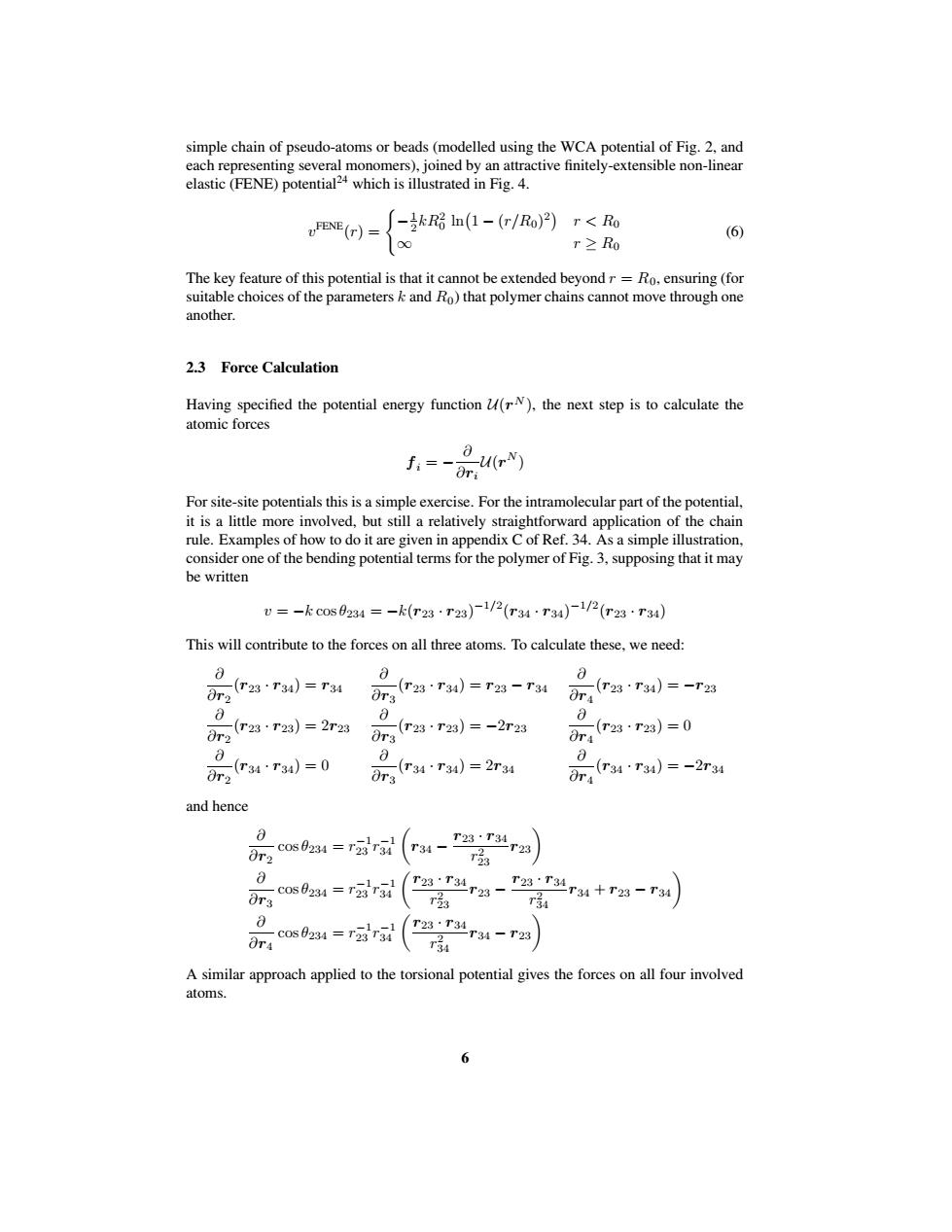正在加载图片...

simple chain of pseudo-atoms or beads(modelled using the WCA potential of Fig.2,and each representing several monomers),joined by an attractive finitely-extensible non-linear elastic (FENE)potential24 which is illustrated in Fig.4. FENE(r)= -kRo In(1-(r/Ro)2)r<Ro (6) T≥Ro The key feature of this potential is that it cannot be extended beyond r=Ro,ensuring(for suitable choices of the parameters k and Ro)that polymer chains cannot move through one another. 2.3 Force Calculation Having specified the potential energy function (rN).the next step is to calculate the atomic forces =-0uy For site-site potentials this is a simple exercise.For the intramolecular part of the potential, it is a little more involved,but still a relatively straightforward application of the chain rule.Examples of how to do it are given in appendix C of Ref.34.As a simple illustration, consider one of the bending potential terms for the polymer of Fig.3.supposing that it may be written v=-kc0s0234=-k(r23·r23)-1/2(r34·r34)-1/2(r23·r34) This will contribute to the forces on all three atoms.To calculate these,we need: 0 -(r23·r34)=T34 0r -(r23T34)=T23-T34 0 O -(r23·T34)=-T23 gr23=2r2 分r23·r23)=-2r23 mr23r2a)=0 元4r3=0 8r94·r34)=2r3别 [r94r3a)=-2r3 and hence cos0234=r23r3 T23·T3 0r T34- T -T23 0 ∂r c0s0234=r23r3 T23:T34r23 T T23T34r31+T23-T34 T34 COs0234=23 T34 T23·T34 0r4 2T34-T23 T34 A similar approach applied to the torsional potential gives the forces on all four involved atoms. 6simple chain of pseudo-atoms or beads (modelled using the WCA potential of Fig. 2, and each representing several monomers), joined by an attractive finitely-extensible non-linear elastic (FENE) potential24 which is illustrated in Fig. 4. v FENE(r) = ( − 1 2 kR2 0 ln 1 − (r/R0) 2 r < R0 ∞ r ≥ R0 (6) The key feature of this potential is that it cannot be extended beyond r = R0, ensuring (for suitable choices of the parameters k and R0) that polymer chains cannot move through one another. 2.3 Force Calculation Having specified the potential energy function U(r N ), the next step is to calculate the atomic forces fi = − ∂ ∂ri U(r N ) For site-site potentials this is a simple exercise. For the intramolecular part of the potential, it is a little more involved, but still a relatively straightforward application of the chain rule. Examples of how to do it are given in appendix C of Ref. 34. As a simple illustration, consider one of the bending potential terms for the polymer of Fig. 3, supposing that it may be written v = −k cos θ234 = −k(r23 · r23) −1/2 (r34 · r34) −1/2 (r23 · r34) This will contribute to the forces on all three atoms. To calculate these, we need: ∂ ∂r2 (r23 · r34) = r34 ∂ ∂r3 (r23 · r34) = r23 − r34 ∂ ∂r4 (r23 · r34) = −r23 ∂ ∂r2 (r23 · r23) = 2r23 ∂ ∂r3 (r23 · r23) = −2r23 ∂ ∂r4 (r23 · r23) = 0 ∂ ∂r2 (r34 · r34) = 0 ∂ ∂r3 (r34 · r34) = 2r34 ∂ ∂r4 (r34 · r34) = −2r34 and hence ∂ ∂r2 cos θ234 = r −1 23 r −1 34 r34 − r23 · r34 r 2 23 r23 ∂ ∂r3 cos θ234 = r −1 23 r −1 34 r23 · r34 r 2 23 r23 − r23 · r34 r 2 34 r34 + r23 − r34 ∂ ∂r4 cos θ234 = r −1 23 r −1 34 r23 · r34 r 2 34 r34 − r23 A similar approach applied to the torsional potential gives the forces on all four involved atoms. 6